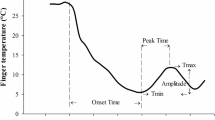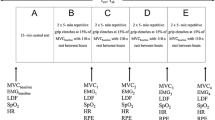Abstract
This study aimed to investigate the effect of repeated cooling of forearm muscle on adaptation in skeletal muscle metabolism. It is hypothesized that repeated decreases of muscle temperature would increase the oxygen consumption in hypothermic skeletal muscle. Sixteen healthy males participated in this study. Their right forearm muscles were locally cooled to 25 °C by cooling pads attached to the skin. This local cooling was repeated eight times on separate days for eight participants (experimental group), whereas eight controls received no cold exposure. To evaluate adaptation in skeletal muscle metabolism, a local cooling test was conducted before and after the repeated cooling period. Change in oxy-hemoglobin content in the flexor digitorum at rest and during a 25-s isometric handgrip (10% maximal voluntary construction) was measured using near-infrared spectroscopy at every 2 °C reduction in forearm muscle temperature. The arterial blood flow was occluded for 15 s by upper arm cuff inflation at rest and during the isometric handgrip. The oxygen consumption in the flexor digitorum muscle was evaluated by a slope of the oxy-hemoglobin change during the arterial occlusion. In the experimental group, resting oxygen consumption in skeletal muscle did not show any difference between pre- and post-intervention, whereas muscle oxygen consumption during the isometric handgrip was significantly higher in post-intervention than in pre-test from thermoneutral baseline to 31 °C muscle temperature (P < 0.05). This result indicated that repeated local muscle cooling might facilitate oxidative metabolism in the skeletal muscle. In summary, skeletal muscle metabolism during submaximal isometric handgrip was facilitated after repeated local muscle cooling.




Similar content being viewed by others
References
Abramson DI, Kahn A, Tuck S Jr, Turman GA, Rejal H, Fleischer CJ (1958) Relationship between a range of tissue temperature and local oxygen uptake in the human forearm. I. Changes observed under resting conditions. J Clin Invest 37(7):1031–1038. doi:10.1172/JCI103684
Bae KA, An NY, Kwon YW, Kim C, Yoon CS, Park SC, Kim CK (2003) Muscle fibre size and capillarity in Korean diving women. Acta Physiol Scand 179(2):167–172. doi:10.1046/j.1365-201X.2003.01185.x
Barany M (1967) ATPase activity of myosin correlated with speed of muscle shortening. J Gen Physiol 50(6):Suppl:197–Suppl:218
Bennett AF (1985) Temperature and muscle. J Exp Biol 115:333–344
Bruton JD, Aydin J, Yamada T, Shabalina IG, Ivarsson N, Zhang SJ, Wada M, Tavi P, Nedergaard J, Katz A, Westerblad H (2010) Increased fatigue resistance linked to Ca2 + −stimulated mitochondrial biogenesis in muscle fibres of cold-acclimated mice. J Physiol 588(Pt 21):4275–4288. doi:10.1113/jphysiol.2010.198598
Cannon B, Nedergaard J (2004) Brown adipose tissue: function and physiological significance. Physiol Rev 84(1):277–359. doi:10.1152/physrev.00015.2003
Crow MT, Kushmerick MJ (1982) Chemical energetics of slow- and fast-twitch muscles of the mouse. J Gen Physiol 79(1):147–166
Deveci D, Egginton S (2002) Differing mechanisms of cold-induced changes in capillary supply in m. tibialis anterior of rats and hamsters. J Exp Biol 205(Pt 6):829–840
Krustrup P, Secher NH, Relu MU, Hellsten Y, Soderlund K, Bangsbo J (2008) Neuromuscular blockade of slow twitch muscle fibres elevates muscle oxygen uptake and energy turnover during submaximal exercise in humans. J Physiol 586(Pt 24):6037–6048. doi:10.1113/jphysiol.2008.158162
Meyer CW, Willershauser M, Jastroch M, Rourke BC, Fromme T, Oelkrug R, Heldmaier G, Klingenspor M (2010) Adaptive thermogenesis and thermal conductance in wild-type and UCP1-KO mice. Am J Physiol Regul Integr Comp Physiol 299(5):R1396–R1406. doi:10.1152/ajpregu.00021.2009
Mineo PM, Cassell EA, Roberts ME, Schaeffer PJ (2012) Chronic cold acclimation increases thermogenic capacity, non-shivering thermogenesis and muscle citrate synthase activity in both wild-type and brown adipose tissue deficient mice. Comp Biochem Physiol A Mol Integr Physiol 161(4):395–400. doi:10.1016/j.cbpa.2011.12.012
Nishimura T, Motoi M, Egashira Y, Choi D, Aoyagi K, Watanuki S (2015) Seasonal variation of non-shivering thermogenesis (NST) during mild cold exposure. J Physiol Anthropol 34(1):11. doi:10.1186/s40101-015-0051-9
Saito M, Okamatsu-Ogura Y, Matsushita M, Watanabe K, Yoneshiro T, Nio-Kobayashi J, Iwanaga T, Miyagawa M, Kameya T, Nakada K, Kawai Y, Tsujisaki M (2009) High incidence of metabolically active brown adipose tissue in healthy adult humans: effects of cold exposure and adiposity. Diabetes 58(7):1526–1531. doi:10.2337/db09-0530
Sillau AH, Aquin L, Lechner AJ, Bui MV, Banchero N (1980) Increased capillary supply in skeletal muscle of guinea pigs acclimated to cold. Respir Physiol 42(3):233–245
Suzuki J, Gao M, Ohinata H, Kuroshima A, Koyama T (1997) Chronic cold exposure stimulates microvascular remodeling preferentially in oxidative muscles in rats. Jpn J Physiol 47(6):513–520. doi:10.2170/jjphysiol.47.513
Thorsson O, Lilja B, Ahlgren L, Hemdal B, Westlin N (1985) The effect of local cold application on intramuscular blood flow at rest and after running. Med Sci Sports Exerc 17(6):710–713
van Beekvelt MCP, Colier WNJM, Wevers RA, van Engelen BGM (2001) Performance of near-infrared spectroscopy in measuring local O2 consumption and blood flow in skeletal muscle. J Appl Physiol (1985) 90:515–519
van Beekvelt MCP, van Engelen BGM, Wevers RA, Colier WNJM (2002) In vivo quantitative near-infrared spectroscopy in skeletal muscle during incremental isometric handgrip exercise. Clin Physiol Funct Imaging 22:210–217. doi:10.1046/j.1475-097X.2002.00420
van der Lans AA, Hoeks J, Brans B, Vijgen GH, Visser MG, Vosselman MJ, Hansen J, Jorgensen JA, Wu J, Mottaghy FM, Schrauwen P, van Marken Lichtenbelt WD (2013) Cold acclimation recruits human brown fat and increases nonshivering thermogenesis. J Clin Invest 123(8):3395–3403. doi:10.1172/JCI68993
van Marken Lichtenbelt WD, Daanen HA (2003) Cold-induced metabolism. Curr Opin Clin Nutr Metab Care 6(4):469–475. doi:10.1097/01.mco.0000078992.96795.5f
van Marken Lichtenbelt WD, Schrauwen P (2011) Implications of nonshivering thermogenesis for energy balance regulation in humans. Am J Physiol Regul Integr Comp Physiol 301(2):R285–R296. doi:10.1152/ajpregu.00652.2010
van Marken Lichtenbelt WD, Vanhommerig JW, Smulders NM, Drossaerts JM, Kemerink GJ, Bouvy ND, Schrauwen P, Teule GJ (2009) Cold-activated brown adipose tissue in healthy men. N Engl J Med 360(15):1500–1508. doi:10.1056/NEJMoa0808718
Vybiral S, Lesna I, Jansky L, Zeman V (2000) Thermoregulation in winter swimmers and physiological significance of human catecholamine thermogenesis. Exp Physiol 85(3):321–326
Wakabayashi H, Oksa J, Tipton MJ (2015) Exercise performance in acute and chronic cold exposure. J Phys Fitness Sports Med 4(2):177–185. doi:10.7600/jpfsm.4.177
Walters TJ, Constable SH (1993) Intermittent cold exposure causes a muscle-specific shift in the fiber type composition in rats. J Appl Physiol (1985) 75(1):264–267
Wijers SL, Schrauwen P, Saris WH, van Marken Lichtenbelt WD (2008) Human skeletal muscle mitochondrial uncoupling is associated with cold induced adaptive thermogenesis. PLoS One 3(3):e1777. doi:10.1371/journal.pone.0001777
Wijers SL, Schrauwen P, van Baak MA, Saris WH, van Marken Lichtenbelt WD (2011) Beta-adrenergic receptor blockade does not inhibit cold-induced thermogenesis in humans: possible involvement of brown adipose tissue. J Clin Endocrinol Metab 96(4):E598–E605. doi:10.1210/jc.2010-1957
Yamakage M, Namiki A (2003) Deep temperature monitoring using a zero-heat-flow method. J Anesth 17(2):108–115. doi:10.1007/s005400300026
Yoneshiro T, Aita S, Matsushita M, Kayahara T, Kameya T, Kawai Y, Iwanaga T, Saito M (2013) Recruited brown adipose tissue as an antiobesity agent in humans. J Clin Invest 123(8):3404–3408. doi:10.1172/JCI67803
Acknowledgments
The authors wish to thank all those who participated in this study. We would also like to express our gratitude to Mr. Mutsuhiro Fijiwara for his technical support. This study was supported by a Grant-in-Aid for Scientific Research (No. 09J03584, No. 26291099) from the Japan Society for the Promotion of Science, and the DESCENTE and ISHIMOTO Memorial Foundation for the Promotion of Sports Science.
Author information
Authors and Affiliations
Corresponding author
Ethics declarations
All experimental protocols in this study were designed according to the principle of the Helsinki Declaration and approved by the Institutional Review Board of Kyushu University. After the ethical approvement, all participants were informed of the experimental procedures and gave their written informed consent before participation.
Conflict of interest
The authors declare that they have no conflict of interest.
Rights and permissions
About this article
Cite this article
Wakabayashi, H., Nishimura, T., Wijayanto, T. et al. Effect of repeated forearm muscle cooling on the adaptation of skeletal muscle metabolism in humans. Int J Biometeorol 61, 1261–1267 (2017). https://doi.org/10.1007/s00484-016-1303-z
Received:
Revised:
Accepted:
Published:
Issue Date:
DOI: https://doi.org/10.1007/s00484-016-1303-z




